Rodney Dangerfield was one of the funniest comics ever. Live stand up, or movies, he was the sharp witted but classless sad sack, who came out on top enough times to make success look possible for… anyone. So after watching the first day of the Supreme Court Justice confirmation hearings, I tore the big screen off the wall, tossed it out onto the front lawn, then broke out the laptop and watched “Easy Money” and “Back to School” to regain a sense of reality.
Just as the T/C Contender began life as a modest power, varmint hunting, single shot pistol and evolved into a success for hunting medium and big game and competitive shooting, the 7-30 Waters developed well beyond its intended applications. In 1976, Ken Waters began development of the cartridge as a high velocity, flat shooting alternative to the 30-30 WCF in fast handling lever action carbines. In 1983, with the 7-30 Waters hitting Federal Cartridge finessed the cartridge into a 120 grain, 2,700 fps commercial version, rated with a 24″ test barrel. In 1984, Winchester’s chambered the 7-30 Water in both Model 94 XTR Angle Eject rifles and carbines 1).
Cartridges of the World reads more like a eulogy for a failed cartridge, citing significant performance loss in less than 24″ barrel lever guns, less performance than the 30-30 WCF at close range and a lack of long range performance for open country hunting. They omitted the cartridge’s success in silhouette events and hunting up to deer size game with the Contender where it remains an active chamber. While factory ammo is limited to one 120 grain Federal load, the handloader has a good deal more latitude.
Can’t buy ’em, make ’em….
I do own a saddle carbine chambered for the 30-30 WCF. No, I do not have a saddle, or a horse for that matter, it is just what they used to call slab sided, short barreled lever action rifles when I was a youngster. And, yes, they did call young people youngsters… back in the fifties and happy days sixties. Anyway, I always have a pile of 30-30 WCF brass, which also happens to be the parent for the 7-30 Waters.
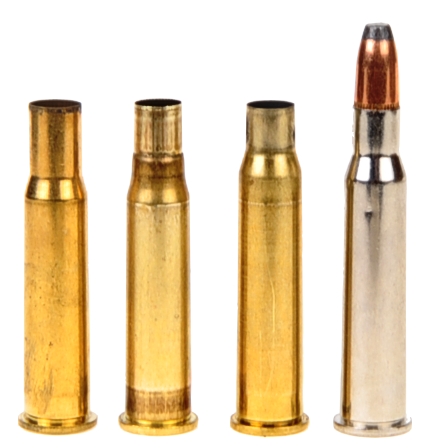
The 30-30 WCF, far left, at 2.039″, is 0.001″ shorter than the 7-30 Waters case and its shoulder is set back approximately 0.099″. Subsequently, forming case is a two step process. The first is a run through a 7-30 Waters sizer die which reduces the neck from 0.308″ to 0.284″ inside diameter, but does not correct the shoulder angle or location, second from left. During this step, the case will grow to approximately 2.050″. Don’t trim it as it will shrink back to 2.040″ at the conclusion of the next step.
The second step in the case forming process is to fire form the necked down case in a 7-30 Waters chambered firearm. In this case, the cartridges received a large rifle primer, twelve grains of IMR Trail Boss and 120 grain Sierra Pro-Hunter bullets. The Trail Boss fills the case as the powder is very low density as a charge, but it is actually a reduced load that yields about 1,250 fps muzzle velocity out of the Contender’s 14″ barrel.
If I do not want to load with a conventional bullet, I use the same 12 grains of Trail Boss, lightly pack in facial tissue up to within an 1/8″ of the case mouth and seal it with a drop of water based rubber cement.The case fully forms, the rubber cement contains no petroleum component and it won’t abrade a firearm’s bore. I’ve seen people suggest paraffin wax for sealing by just poking the case neck into a paraffin wax block. Paraffin is a petroleum distillate that will contaminate powder it contacts.
Once fired, the case is decapped and run through a sizer die, cleaned, checked for proper case length and trimmed if necessary, charged and bullet seated as defined in load data. If the case is to be recycled routinely in handloads, they are annealed as the 30-30 WCF brass is thin and work hardens quickly when forming and firing.
Gauging not guessing…
The Thompson/Center Contender offers a good deal of latitude in setting cartridge overall length, but a simple gauge is needed to exercise the potential. Seating bullets out further, but safely away from loaded contact with rifling, recovers net case capacity and gives more leeway in load development. Unfortunately, Hornady does not make a modified case for the 7-30 Waters. Fortunately, modified cases are easy to make.
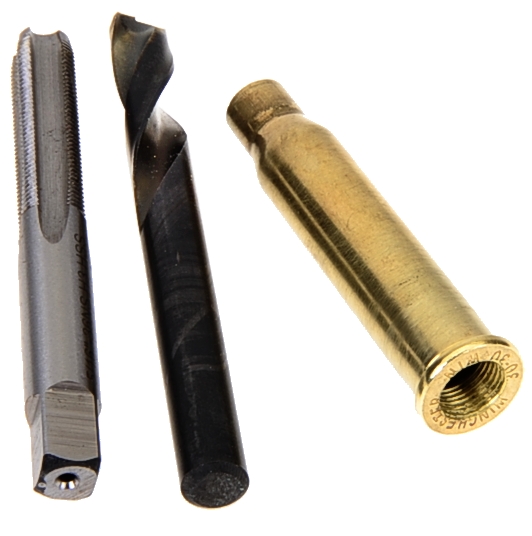
A fire formed case was decapped,but not sized, which allowed a bullet to slide within the case neck with light finger pressure. The case was chucked in the lathe’s spindle, a drill is chucked in the tailstock and the primer pocket is turned into a through hole. The case is removed from the lathe and the new hole is hand tapped. I use a 7.2mm screw machine drill and a high speed steel 5/16″-36 tap. I apologize profusely to skilled machinists worldwide for treating their craft in such a haphazard manner. Still, if done correctly, the modified case should mount on a OAL gauge something like this –

A standard, straight OAL gauge can be used to check for bullet/rifling clearance on the T/C Contender, however, the barrel must removed from the frame. With the barrel mounted and action open, the extractor is extended and prevents a cartridge from being fully chambered until the action is closed. Like the 30-30 WCF, the 7-30 Waters headspaces on the case’s rim. With the barrel removed, the extractor is seated and the gauge can be fully chambered.
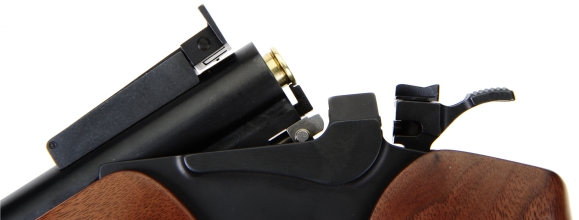
Below, modified case fully seated without and with OAL gauge in place. Measurements by this method contributed to the bullet selection for this project.
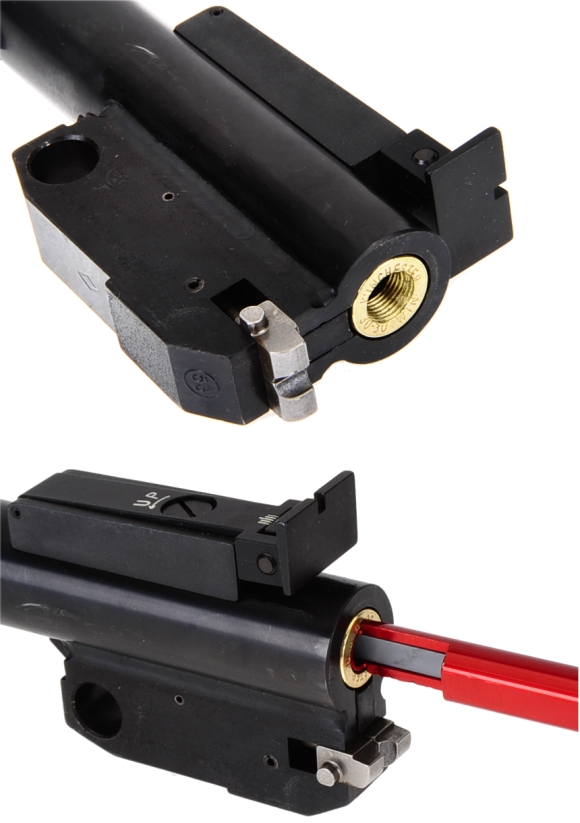
Bullet selection
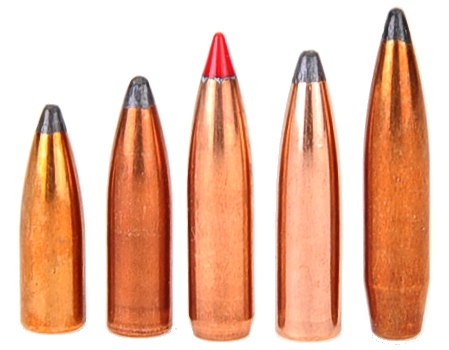
A bit of picking and poking and picking some more was required to get to the final bullet selection. The above were selected because they do not have a cannelure and could be set to suit the Contender without having an unsightly groove showing above the case mouth, they have jackets that will upset at anticipated Contender velocity levels, they covered the useful weight span for medium to large game. I saw no reason to grab for the lightest weight to achieve the highest velocity as this was inconsistent with the strategy of a 14″ barrel and a single shot pistol… no 500 yard antelope hunts planned.
| Bullet | Type | Weight Grains |
Length” | Contact OAL Length ” |
Load OAL Length “ |
| Sierra Pro-Hunter | SPFB | 120 | 0.975 | 2.810 | 2.750 |
| Speer Hot-Cor | SPFB | 145 | 1.110 | 2.790 | 2.770 |
| Nosler Ballistic Tip | PTBT | 150 | 1.310 | 2.890 | 2.870 |
| Speer Hot-Cor | SPFB | 160 | 1.230 | 2.935 | 2.915 |
| Sierra-Game King | SPBT | 175 | 1.410 | 2.885 | 2.865 |
Contact OAL Length is the length where the bullet is extended until it is in contact with rifling. Load OAL Length is the Contact Length reduced by 0.020″ for safe clearance or reduced enough to assure adequate seating depth. We’ll take a break here, combine handloads with scoped Contender and see how all of this shakes out.
1) Cartridges of the World: A complete and Illustrated Reference for over 1500 Cartridges – Frank C Barnes. The Handloader’s Manual of Cartridge Conversions – John J. Donnelly

Email Notification